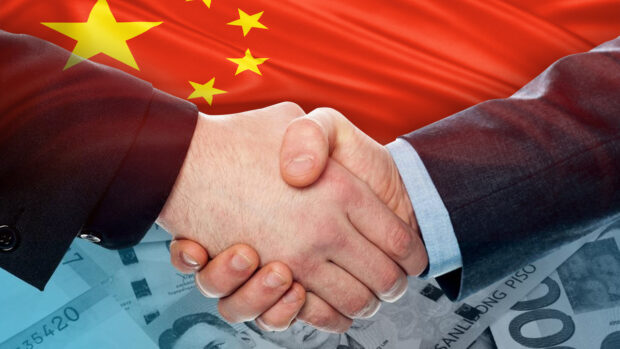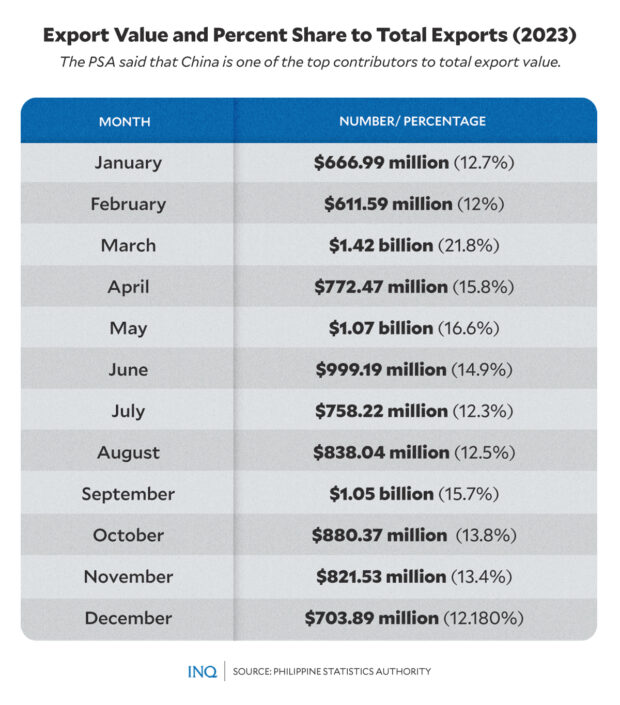WPS economic sanctions to hurt PH, but China even more
MANILA, Philippines—The shift in policy on the West Philippine Sea (WPS) from Rodrigo Duterte’s appeasement to Ferdinand “Bongbong” Marcos Jr.’s assertiveness has raised fears, baseless or not, over the row’s impact on China’s investments in and trade with the Philippines.
Here’s why.
According to a 2022 policy paper written by Erick Nielson Javier, a defense research officer of the Research and Special Studies Division of the National Defense College of the Philippines (NDCP), “research focusing on the People’s Republic of China and its use of economic statecraft, including economic coercion, has started to emerge in recent years.”
“With its increasing economic clout, being the second largest economy in the world, the world’s largest trading state, and the world’s largest holder of foreign currency reserves, it is therefore unsurprising that China is using its newfound economic power as leverage in dealing with other states,” it read.
READ: Expert commends PH efforts to expose China actions in WPS
As cited in the article, Jonathan Kirshner, a professor of political science and international studies in the United States, explained that economic coercion, especially on trade, is highly likely. As the NDCP report said, the Philippines has experienced it already after the Panatag (Scarborough) Shoal standoff between the Philippine and Chinese navies in 2012.
The report pointed out that China’s retaliation was to ban agricultural products, especially bananas, from the Philippines. Chinese citizens were discouraged, too, from visiting the Philippines because of “security concerns.”
This also was the point made by Collin Koh, a senior fellow at the S. Rajaratnam School of International Studies in Singapore’s Nanyang Technological University, in a column published by ISEAS-Yusof Ishok Institute.
“After all, the weaponization of trade and investments is not new to Beijing’s modern statecraft,” Koh said in the column.
“As China remains a major trade partner of the Philippines, one could justifiably assume that Beijing might seek to tighten the economic pressure valve on Manila in retaliation,” Koh said.
It was explained to INQUIRER.net by Herman Joseph Kraft, a professor of political science at the University of the Philippines Diliman, that “economic sanctions are serious actions taken by states against another.”
“Usually it is taken when one party has crossed a line that is a serious threat to the interests of another,” Kraft said.
However, Koh pointed out that so far, “there are no indications of coercive economic reprisals from China,” especially since the start of the Philippines’ strategy of publicizing China’s aggression in the South China Sea. This included non-lethal attacks, like aiming military-grade lasers, on Philippine Coast Guard vessels inside the Philippines’ exclusive economic zone.
READ: 2023: A lookback at rising tension in West PH Sea
In 2023, the Chinese Embassy spokesperson said “China remains the Philippines’ largest trading partner, largest source of imports, largest export destination and third largest source of foreign investment under agreements.”
This, he said, has effectively promoted post-pandemic recovery.
Trading partner?
Philippine Statistics Authority (PSA) data in 2023 showed that the Philippines was buying more goods than it was selling to China. Last year, China was the biggest source of imported goods with a value of $29.4 billion that peaked in November that year with $2.72 billion worth of Chinese goods being sold to the Philippines, or 25.1 percent of the Philippines’ total imports.
Next to China were Indonesia ($11.694 billion), Japan ($10.165 billion), and the US ($8.35 billion).
The problem, however, is that a good balance of trade is “one in which the value of domestic goods exported exceeds the value of foreign goods imported,” said Douglas Irwin, a professor of economics in the US, in an article published by Econlib.
Taking a look at the balance of trade, the same PSA data showed that in 2023, exports — or Philippine-made goods being sold to China — were worth nearly $11 billion, or just half of what China is selling to the Philippines. March was the peak for exports to China with goods worth $1.4 billion or 21 percent of total Philippine exports that month. The US was the biggest export market with a value of $11.2 billion.
Next to the US and China were Japan ($10.511 billion) and Hong Kong ($8.390 billion).
As explained in the website investopedia.com, when there are too many imports coming into a country in relation to its exports—which are products shipped from that country to a foreign destination—it can distort a nation’s balance of trade and devalue its currency.
Less investments
Marcos said last year that when he met with Chinese President Xi Jinping at the Asia-Pacific Economic Conference summit, “essentially […] we were in agreement that the problems […] in the South China Sea should not be the defining element of our relationship.”
One way economic interest in the Philippines is being measured is through foreign direct investments or FDIs.
RELATED STORY: PH not provoking conflict in West Philippine Sea — AFP
The Philippines’ Bangko Sentral ng Pilipinas explained that foreign direct investments “are an important source of external financing for developing countries,” stressing that “given its long-term nature, it provides a stable source of funding for host or receiving economies.”
According to data from the PSA, approved investments from China from 2016 to the second quarter of 2023 was valued at $163.802 billion, behind Japan, which had $282.355 billion, and Singapore, which had $237.988 billion. The US only had $111.775 billion in approved investments.
The data indicated that in both the last quarters of 2018 and 2019, approved investments from China reached P47.985 billion and P86.311 billion. It hit its lowest in the second quarter of 2020 at only P69.70 million.
The value of approved agreements in the first year of Marcos was almost the same as in Duterte’s.
As stressed in a 2017 article by foreign affairs research specialist Edcel John Ibarra and published by the Center for International Relations and Strategic Studies, Japan, the US, and Singapore, which are also significant trading partners, “are keen to counterbalance an aggressively rising China.”
Imbalance
For Joshua Espeña, vice president of the think tank International Development and Security Cooperation, “doing nothing or something would hurt the Philippines’ economy; our economy is already hurt because of the imbalanced trade.”
“It would imply either looking for other import sources with the same production rate or as close to China or forcing its domestic private sectors to produce more,” he told INQUIRER.net, stressing, however, that “the costs will be at the household level in the medium term.”
“But the long-term implication is to help the Filipino economy eventually niche in the global market,” said Espeña.
“So far, doing nothing is already hurting our development plans. If the Philippines wishes to leverage its newfound middle power position, geoeconomics is integral to any rising state actor in the international system,” he said.
READ: ‘Laban ng lahat’: Civilian role in kicking China out of PH waters growing, crucial
Espeña, also a lecturer at the Polytechnic University of the Philippines, pointed out that should China decide to sanction the Philippines, “it will hurt us, but it will also hurt China in terms of global supply chain.”
Fostering economic blocs, he said, is a way forward to consider mini-lateral approaches with certain ASEAN members and like-minded partners, and pushing for the US-led Indo-Pacific Economic Framework.
“We hedge the sources, but we must craft a pro-Filipino grand strategy to lift the Filipino people to greater heights,” he said.
READ: Hit China where it hurts
No economic coercion, yet
But despite the more assertive actions taken by the Philippines in securing its rights in the WPS, Kraft said that “it doesn’t seem like it has reached a point where China will resort to economic sanctions.”
“There might be some targeted actions against particular industries that would be tantamount to harassment, but full-blown economic sanctions are not yet likely in the short term and under current circumstances,” he explained.
This was shared by Espeña, who pointed out that “as far as we are concerned, it is likely that China would think twice about hitting us with economic sanctions hard given the state of their domestic economy whose development model is now geared toward exporting goods and services.”
“Beijing’s model has created a monster of making more and imposing it on them. So I think their post-COVID economic policy is to offset the loss of the export hurt exacerbated by its trade war with Washington,” he said.
“We have to take into account that China’s disinformation campaign and diplomatic threats are another window of seeing how vulnerable they are without securing the regional supply chain,” Espeña said.
“For instance, China gets most of its nickel sources from the Philippines, so it goes on to suggest we may have more leverage in fostering a geoeconomic agenda of hurting their supply chain,” he added.



















